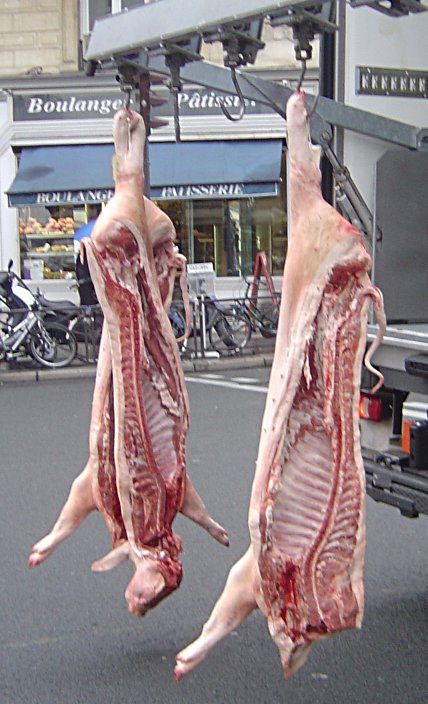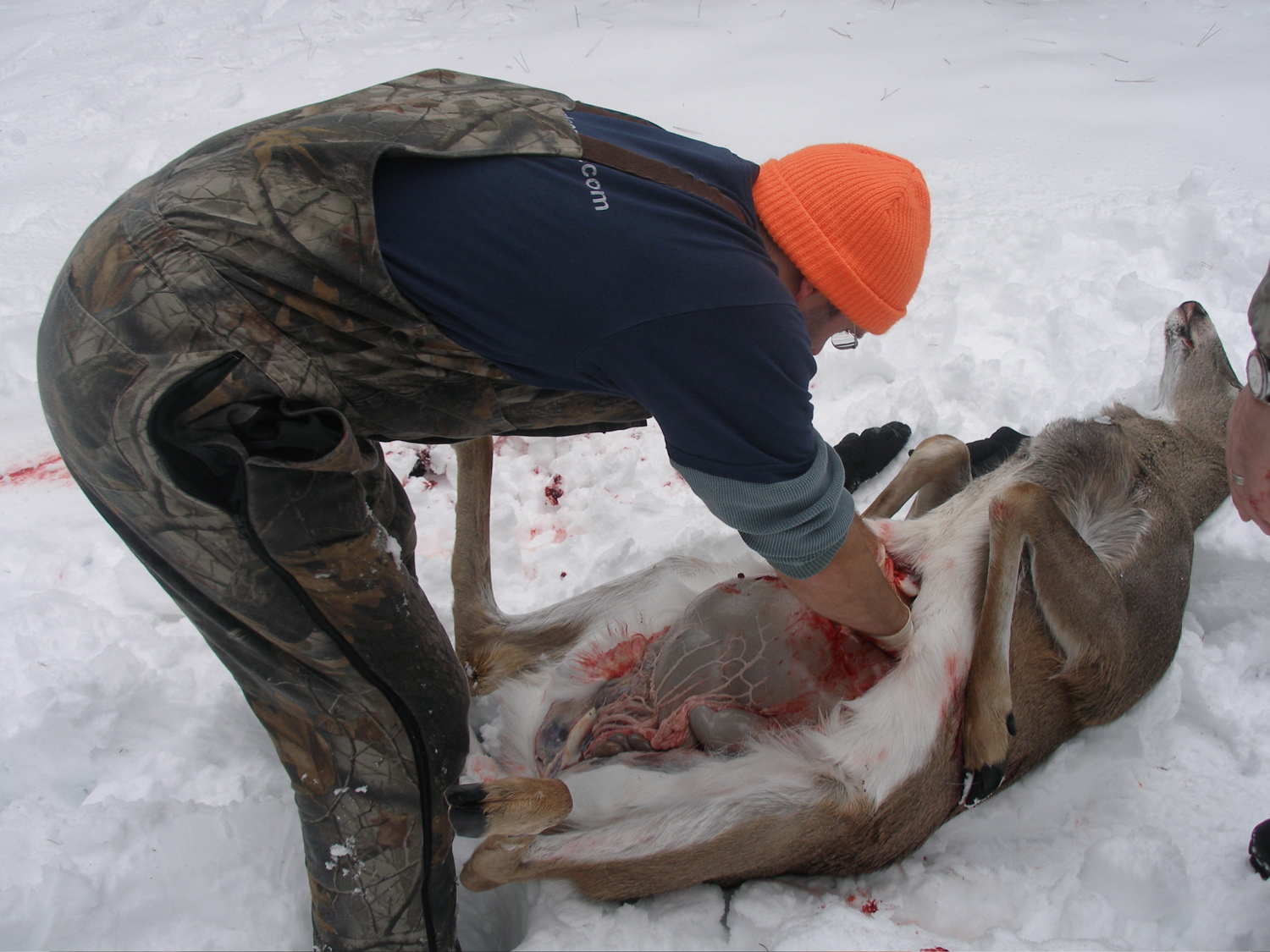Dressed weight on:
[Wikipedia]
[Google]
[Amazon]
 Dressed weight (also known as dead weight or carcass weight) refers to the weight of an animal after being partially butchered, removing all the internal organs and oftentimes the head as well as inedible (or less desirable) portions of the tail and legs. It includes the bones, cartilage and other body structure still attached after this initial butchering. It is usually a fraction of the total weight of the animal, and an average of 59% of the original weight for
Dressed weight (also known as dead weight or carcass weight) refers to the weight of an animal after being partially butchered, removing all the internal organs and oftentimes the head as well as inedible (or less desirable) portions of the tail and legs. It includes the bones, cartilage and other body structure still attached after this initial butchering. It is usually a fraction of the total weight of the animal, and an average of 59% of the original weight for
 Field dressing is the act of minimally dressing (
Field dressing is the act of minimally dressing (
Fed Cattle Pricing: Live and Dressed Weight
- Oklahoma Cooperative Extension Fact Sheet Agriculture in the United States Measurement
 Dressed weight (also known as dead weight or carcass weight) refers to the weight of an animal after being partially butchered, removing all the internal organs and oftentimes the head as well as inedible (or less desirable) portions of the tail and legs. It includes the bones, cartilage and other body structure still attached after this initial butchering. It is usually a fraction of the total weight of the animal, and an average of 59% of the original weight for
Dressed weight (also known as dead weight or carcass weight) refers to the weight of an animal after being partially butchered, removing all the internal organs and oftentimes the head as well as inedible (or less desirable) portions of the tail and legs. It includes the bones, cartilage and other body structure still attached after this initial butchering. It is usually a fraction of the total weight of the animal, and an average of 59% of the original weight for cattle
Cattle (''Bos taurus'') are large, domesticated, cloven-hooved, herbivores. They are a prominent modern member of the subfamily Bovinae and the most widespread species of the genus '' Bos''. Adult females are referred to as cows and adult ...
. There is no singular way to dress an animal, as what is removed depends on whether it will be cooked whole, or butchered further for sale of individual parts. For pigs, the dressed weight typically includes the skin, while most other ungulates
Ungulates ( ) are members of the diverse clade Ungulata which primarily consists of large mammals with hooves. These include odd-toed ungulates such as horses, rhinoceroses, and tapirs; and even-toed ungulates such as cattle, pigs, giraffes, ca ...
are typically dressed without. For fowl
Fowl are birds belonging to one of two biological orders, namely the gamefowl or landfowl (Galliformes) and the waterfowl (Anseriformes). Anatomical and molecular similarities suggest these two groups are close evolutionary relatives; together ...
, it is calculated with skin but without feathers. It can be expressed as a percentage of the animal's live weight, when it is known as the killing out percentage.
Factors affecting dressed weight
The net dressed weight can vary dramatically from animals of the same type depending on how much fat is trimmed in the dressing process, how lean the animal is at butcher time, and if the animal has eaten shortly before slaughter. From the perspective of economics, understanding the average dressed weight as a ratio to the live weight is a necessary function of the cattle and other meat industries, as it allows a rough estimate of the available return for each animal. The dressed weight of an animal will still be higher than the net retail weight of final product at the market, as additional trimming and deboning generally take place for the individual cuts. Dressed weight also varies by animal. For example, the dress weight for chickens and other fowl is closer to 75% of the live weight, which is significantly higher than that of cattle, which can be from 50-70% depending on breed and methods used. To compare, a 250-pound pig will typically have a dressed weight of 180 pounds and a retail cuts weight of 144 pounds. This is a net of 72% dressed weight, with only 57% of the original live weight becoming retail cuts.Byproducts
Most of the material that is removed in a primary commercial dressing is not disposed of, but is processed or sold individually. This includes some of the organs such as theliver
The liver is a major organ only found in vertebrates which performs many essential biological functions such as detoxification of the organism, and the synthesis of proteins and biochemicals necessary for digestion and growth. In humans, it i ...
, kidneys
The kidneys are two reddish-brown bean-shaped organs found in vertebrates. They are located on the left and right in the retroperitoneal space, and in adult humans are about in length. They receive blood from the paired renal arteries; bloo ...
and even tongue
The tongue is a muscular organ in the mouth of a typical tetrapod. It manipulates food for mastication and swallowing as part of the digestive process, and is the primary organ of taste. The tongue's upper surface (dorsum) is covered by taste ...
. Other parts that may be sold for human consumption include chitterlings
Chitterlings (), sometimes spelled chitlins or chittlins, are the small intestines of domestic animals. They are usually made from pigs' intestines. They may also be filled with a forcemeat to make sausage.''Oxford English Dictionary'', 1st edit ...
, tripe
Tripe is a type of edible lining from the stomachs of various farm animals. Most tripe is from cattle, pigs and sheep.
Types of tripe
Beef tripe
Beef tripe is made from the muscle wall (the interior mucosal lining is removed) of a cow's ...
, brain
A brain is an organ (biology), organ that serves as the center of the nervous system in all vertebrate and most invertebrate animals. It is located in the head, usually close to the sensory organs for senses such as Visual perception, vision. I ...
, and feet, such as pig's trotters
A pig's trotter, also known as a pettitoe, or sometimes known as a pig's foot, is the culinary term for the foot of a pig. The cuts are used in various dishes around the world, and experienced a resurgence in the late 2000s.
Description
Pigs' ...
or chicken feet. In some countries, there is an excess supply of these internal organs versus the demand for them, so they will simply be used as a byproduct food. The bone is pulverized to make bone meal, and like much of trimmed material, is used for animal feed, such as dog food. These items are not counted toward the dressed weight, which is focused primarily on the more desirable meat tissues.
Field dressing
 Field dressing is the act of minimally dressing (
Field dressing is the act of minimally dressing (butcher
A butcher is a person who may slaughter animals, dress their flesh, sell their meat, or participate within any combination of these three tasks. They may prepare standard cuts of meat and poultry for sale in retail or wholesale food establishm ...
ing) an animal in a way as to reduce the amount of weight that must be carried by removing the rumen
The rumen, also known as a paunch, is the largest stomach compartment in ruminants and the larger part of the reticulorumen, which is the first chamber in the alimentary canal of ruminant animals. The rumen's microbial favoring environment al ...
("gutting"), and sometimes other internal organs such as the heart. This is commonly done by hunters
Hunting is the human activity, human practice of seeking, pursuing, capturing, or killing wildlife or feral animals. The most common reasons for humans to hunt are to harvest food (i.e. meat) and useful animal products (fur/hide (skin), hide, ...
of larger game
A game is a structured form of play, usually undertaken for entertainment or fun, and sometimes used as an educational tool. Many games are also considered to be work (such as professional players of spectator sports or games) or art (suc ...
such as deer
Deer or true deer are hoofed ruminant mammals forming the family Cervidae. The two main groups of deer are the Cervinae, including the muntjac, the elk (wapiti), the red deer, and the fallow deer; and the Capreolinae, including the re ...
or elk. The practice also prevents tainting of the meat by prolonged storage before refrigeration. This type of dressing leaves the skin intact, as a protective barrier against foreign objects and dirt. Typically, the animal will be properly and fully dressed at a later time, further reducing the net dressed weight.
See also
*Butcher
A butcher is a person who may slaughter animals, dress their flesh, sell their meat, or participate within any combination of these three tasks. They may prepare standard cuts of meat and poultry for sale in retail or wholesale food establishm ...
*Meat
Meat is animal flesh that is eaten as food. Humans have hunted, farmed, and scavenged animals for meat since prehistoric times. The establishment of settlements in the Neolithic Revolution allowed the domestication of animals such as chic ...
References
{{reflistExternal links
Fed Cattle Pricing: Live and Dressed Weight
- Oklahoma Cooperative Extension Fact Sheet Agriculture in the United States Measurement